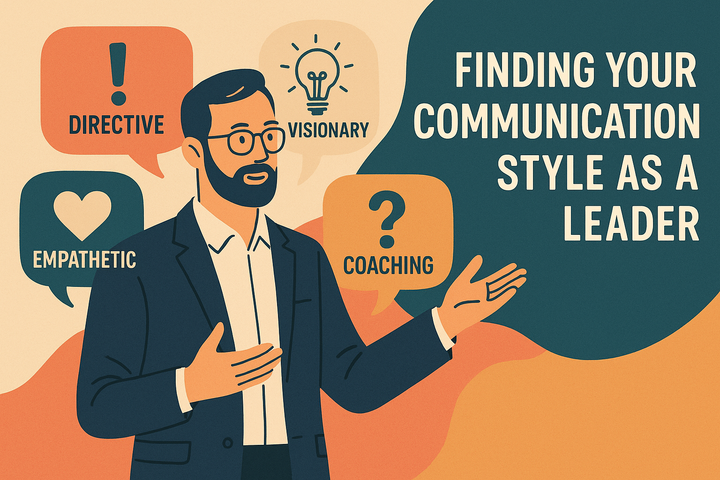Executive Communication Checklist: 5 Keys to Success
Master five essential communication skills to enhance executive leadership, build trust, and drive organisational success.

Want to improve your executive communication? Here's how:
Effective communication is vital for UK executives to lead teams, align goals, and build trust. This checklist breaks down 5 essential skills to master:
- Clear Message Delivery: Be concise, structured, and easy to understand.
- Listening Skills: Pay full attention, ask questions, and observe non-verbal cues.
- Emotional Intelligence (EQ): Recognise and manage emotions to connect better.
- Business Storytelling: Use relatable stories to simplify ideas and inspire action.
- Message Tailoring: Adapt your approach to fit your audience's needs.
These skills reduce misunderstandings, improve productivity, and strengthen relationships. Start applying them today to see immediate results.
1. Clear Message Delivery
What Makes Clear Communication
Effective executive communication relies on being clear, honest, flexible, and empathetic. This approach ensures messages are easy to understand, trustworthy, tailored to the audience, and considerate of different viewpoints - key factors for driving action and aligning with organisational goals.
Methods to Improve Clarity
Here are some practical ways to make your message clearer:
- Start with the 'Why': Clearly explain the purpose and importance of your message.
- Apply the 'So What?' Test: Ask yourself, "What does this mean for my audience?" This ensures you're delivering something meaningful.
- Structure Your Message: Begin with a high-level overview, then move to specific details in a logical order.
For example, break your communication into three parts:
- Strategic Context: Set the scene (e.g., "This supports our Q2 growth targets").
- Core Message: Highlight the main point (e.g., "We're restructuring our supply chain").
- Action Items: Specify the next steps (e.g., "Submit transition plans by 5 pm Friday").
Case Study: United Airlines

In 2017, Oscar Munoz, the CEO of United Airlines, handled the infamous overbooked flight incident with a clear and empathetic response. His approach:
- Admitted the airline's mistakes and expressed regret.
- Explained the steps being taken to prevent similar issues in the future.
- Maintained open communication to rebuild public trust.
Improving your listening skills is the next step to fostering deeper engagement and understanding.
C-Suite Communication Skills You NEED to Master
2. Listening Skills
Once your message is clear, the next step is to strengthen connections through attentive listening.
Listening effectively is a key element of executive communication. It requires focus, understanding, and a genuine respect for others. Damon Lembi, CEO of Learnit, puts it perfectly:
"Leadership-level listening requires new mental models and deliberate practice, but it may be the secret superpower behind continued advancement. Great leaders are expert listeners."
Leadership-level listening revolves around three main principles:
- Engagement: Paying full attention to the speaker.
- Tuning in: Picking up on both spoken words and unspoken cues.
- Respect: Valuing the perspectives of others.
How to Improve Your Listening
"Multitasking is really the art of doing two things badly instead of one thing well."
To listen more effectively:
- Set aside dedicated time and silence your devices.
- Find a quiet environment free from distractions.
- Focus entirely on the person speaking.
- Observe body language and emotional cues.
- Ask questions to ensure you fully understand.
Building emotional intelligence can take these listening skills to the next level.
3. Using Emotional Intelligence
Expanding on active listening, emotional intelligence (EQ) takes communication a step further by helping leaders understand and manage emotions - their own and others'. This skill plays a key role in effective leadership communication.
What Is Emotional Intelligence?
EQ is made up of four main areas that directly influence how well you communicate:
- Self-awareness: Understanding your emotions and how they affect your behaviour.
- Self-management: Keeping your emotional responses in check.
- Social awareness: Picking up on others' emotions and understanding group dynamics.
- Relationship management: Building strong connections and positively influencing others.
These areas enhance listening by helping you focus not just on words but also on the emotions behind them.
How to Strengthen EQ
Improving your emotional intelligence takes effort and consistency. Here are some steps to get started:
- Ask for honest feedback and track your progress with simple tools.
- Review your interactions to identify emotional triggers.
- Listen attentively and show you understand by acknowledging others' feelings.
"Sustainable behavioral change - that means changing and making the change stick–is based on a transfer of ownership to the individual." - LeaderFactor
4. Business Storytelling
Use emotional intelligence (EQ) to craft clear, compelling stories that connect with your audience, share key ideas, and inspire action. With the insights gained through EQ, transform emotions into stories that truly resonate.
Stories in Leadership
Stories are powerful tools in leadership. They help create emotional connections, simplify complex topics, establish trust, and encourage action.
Story Structure Tips
When building your story, focus on your audience's needs and concerns. Here's how to do it effectively:
- Start with your main message: Get straight to the point to grab attention.
- Be genuine: Share real experiences to build trust.
- Consider your audience's perspective: Tailor your story to align with their priorities.
- Show empathy: Acknowledge and address their concerns.
- Keep it concise: Remove anything that doesn't directly support your message.
5. Message Tailoring
Understanding Your Audience
Once you've focused on clarity, active listening, and emotional intelligence, the next step is tailoring your message. Start by identifying what's important to your audience and how it aligns with your goals. Consider potential resistance points like "I Don't Get It", "I Don't Like It", and "I Don't Like You." Assess the influence of stakeholders to predict challenges and form strategic partnerships.
Adjusting Your Message
Customise your communication approach based on your audience insights:
- Connect to strategy: Clearly explain the "why" and "why now" to address "I Don't Get It."
- Show empathy: Recognise and validate concerns to tackle "I Don't Like It."
- Build trust: Demonstrate consistency and integrity to counter "I Don't Like You."
These strategies help fine-tune your message for maximum impact. For a concise overview of all five keys, refer to the Quick Reference Guide.
Quick Reference Guide
Evaluate your progress across five key communication areas using this checklist. Score each element from 1 (needs improvement) to 5 (excellent).
Clear Message Delivery
- Language: Stick to plain English and avoid jargon.
- Brevity: Share key points in under three minutes.
- Outcomes: Focus on results rather than activities.
Key Questions: Is your message easy to understand and actionable?
Success Indicators: Clear next steps and minimal need for clarification.
Listening Skills
- Attention: Fully focus on the speaker.
- Comprehension: Confirm understanding by asking questions.
- Non-verbal: Pay attention to body language and tone.
Key Questions: Do you show active, engaged listening?
Success Indicators: Improved understanding and stronger relationships.
Emotional Intelligence
- Empathy: Acknowledge others' perspectives and emotions.
- Flexibility: Adjust your approach based on reactions.
- Calmness: Stay composed during challenges.
Key Questions: Do you build genuine connections?
Success Indicators: Deeper trust and stronger relationships.
Business Storytelling
- Structure: Use a clear narrative arc.
- Impact: Motivate action or change.
- Sincerity: Share real, meaningful experiences.
Key Questions: Does your storytelling inspire action?
Success Indicators: Greater engagement and lasting impressions.
Message Tailoring
- Audience: Understand their needs and concerns.
- Solutions: Present clear solutions, not just problems.
Key Questions: Does your message connect with different audiences?
Success Indicators: Positive feedback and achieved objectives.
Use this guide before important presentations to identify areas for immediate improvement.
Results Comparison
The Quick Reference Guide outlines five key skills that lead to measurable outcomes:
- Clear message delivery: Reduces follow-up questions and speeds up decision-making.
- Listening skills: Boosts staff engagement and helps resolve problems more efficiently.
- Emotional intelligence: Encourages better teamwork and reduces workplace conflicts.
- Business storytelling: Enhances recall of important messages and supports new initiatives.
- Message tailoring: Aligns stakeholders more effectively and streamlines project execution.
In UK boardrooms, executives who combine clear communication with tailored messaging often see improved productivity, stronger stakeholder relationships, and smoother change management. These skills go beyond being "soft" - they're essential for driving organisational success and improving team dynamics.
Next Steps: Putting the Five Keys into Practice
Integrating the five communication principles into your leadership routine requires consistent effort and practical steps. Here's how you can make them part of your daily habits:
- Ask for constructive feedback: Regularly seek input from colleagues and mentors to fine-tune your communication style.
- Practise through role-play: Simulate challenging conversations with your team to build confidence and improve your approach.
- Enhance your skills with training: Enrol in executive communication programmes that provide structured learning, expert advice, and hands-on practice.
- Simplify complex ideas: Transform key points into clear, relatable stories to ensure your message resonates.



